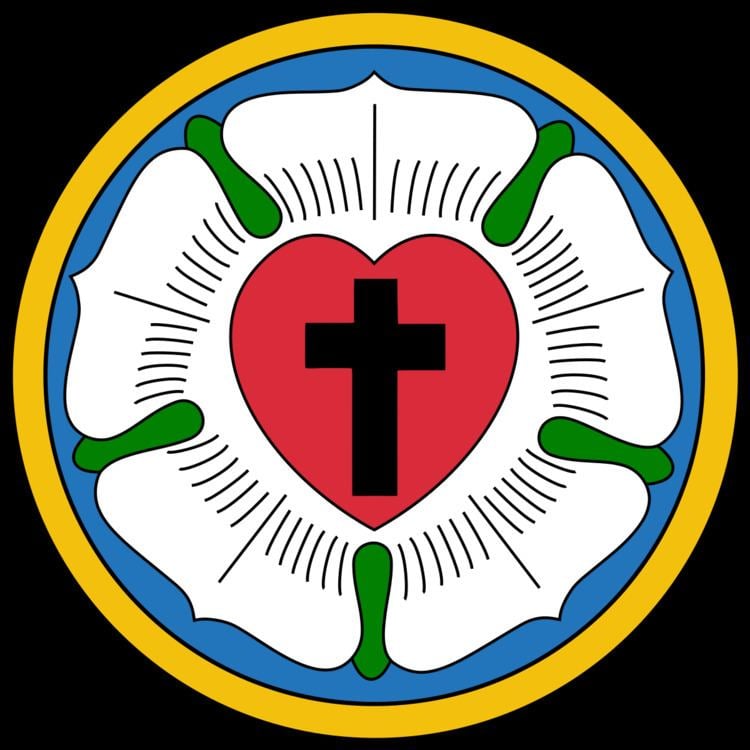 | ||
The Association of Evangelical Lutheran Churches (AELC) was a U.S. church body that existed from 1976 through the end of 1987. The AELC formed when approximately 250 dissident congregations withdrew from the Lutheran Church - Missouri Synod (LCMS) in 1976, and ended as an independent body when it became part of the new Evangelical Lutheran Church in America (ELCA) on January 1, 1988.
Contents
Formation
The AELC's forerunner was Evangelical Lutherans in Mission (ELIM), a liberal caucus within the LCMS that opposed the Synod's more conservative turn in the early and mid-1970s. ELIM was formed when, in the wake of conservative victories at the Missouri Synod's 1973 convention, liberal opponents had convened a conference in Chicago to chart out strategies. The conference's 800 delegates promised moral and financial support for church members who faced pressure due to their opposition to LCMS convention actions, and established ELIM as a network and rallying point for the moderate wing of the LCMS.
In 1974, the LCMS was rent by the Seminex controversy, a walk-out by the vast majority of students and faculty at Concordia Seminary in St. Louis, Missouri, that led to the establishment of a new, rival "Seminary in Exile." In 1975, presidents of eight LCMS districts were threatened with removal from office for allowing their congregations to ordain Seminex graduates as ministers, and four were removed in April 1976. In the wake of the Seminex controversy and these removals, a movement to leave the Synod took shape among dissident congregations and church officials, most of them members of ELIM. The largest number of departures came from the LCMS's non-geographical English District, which had joined the LCMS in 1911. Upon leaving the Missouri Synod, the English District leadership and many of its congregations immediately reconstituted the pre-1911 English Synod, and a number of officials and congregations from other districts followed their lead by exiting the LCMS.
In the end, approximately 250 congregations left the Missouri Synod. In December 1976, these congregations banded together to form a new, independent church body, the Association of Evangelical Lutheran Churches (AELC). Not surprisingly, the AELC proved to be more socially and theologically liberal than the LCMS, and shortly after its inception, it departed from LCMS practice on ordination by opening the ministry to women with the ordination of Pastor Janith Otte-Murphy. The AELC was a disappointment in some respects, since it garnered far fewer dissident Missouri Synod congregations than its leaders had initially expected. With congregations totaling about 100,000 members, the AELC represented less than 4% of the membership of the 2.7-million-strong Missouri Synod.
In October 1977, the AELC ordained its first female minister, Janith Otte Murphy of Oakland, California, and Murphy subsequently took up an associate pastor's position at the University Lutheran Chapel in Berkeley, California. The AELC was the third U.S. Lutheran church body to ordain a woman as a minister, following similar moves by the American Lutheran Church and the Lutheran Church in America in 1970.
The Rev. Will L. Herzfeld, an associate of Martin Luther King, Jr. and former president of the Southern Christian Leadership Conference's Alabama chapter, served as the AELC's second and last presiding bishop. He was the first African American to lead a U.S. Lutheran church body.
Merger
The AELC did play an important role in efforts toward Lutheran unity in the United States. It drew on the expertise of C. Thomas ("Tom") Spitz, who was Executive Director of the Lutheran Council in the United States of America (LCUSA). Spitz was familiar with the polity of all Lutheran bodies and in 1978 authored "A Call for Lutheran Union," which was adopted by the three church bodies and culminated in their merger in the Evangelical Lutheran Church in America. The AELC's leaders, Seminex president John Tietjen among them, served as the catalyst for merger talks between two other Lutheran church bodies: the American Lutheran Church (with approximately 2.25 million members), and the Lutheran Church in America (with approximately 2.85 million members). These two churches, both also more moderate than the Missouri Synod, agreed along with the AELC in 1982 to unite as one church. The three bodies officially completed their merger on January 1, 1988, thereby creating the Evangelical Lutheran Church in America (ELCA). The ELCA today is the largest and most liberal Lutheran church body in the United States.
Presidents/Presiding Bishops
Note: The designation used for the AELC leader was initially "president," although the title was later changed to "presiding bishop."
